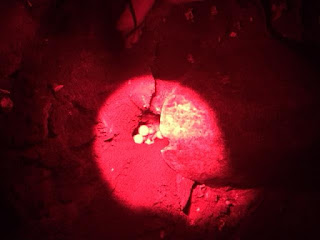The owners of the condo where we're staying live in Houston, TX, but were here this week checking in on things, so we got the opportunity to meet them. While they've both lived in Texas for more than 30 years, she was born in Costa Rica and he was born in Nicaragua. They still have family in both locations and were able to give us some great advice on things to do in both countries. Due to ice in Houston, their return flight got delayed a few days so we joined them on a couple of excursions as they played tourists.
Wednesday: We left at 6:30pm and drove to Ostional Wildlife Refuge in hopes of seeing Olive Ridley turtles. It's about an hour and a half drive and a good hour of that is on a dirt road. The first thing we noticed when we got out of the van was how dark it was and how bright the stars were. Turtles are drawn to light which can disorient them, so lighting is kept at a bare minimum and only flashlights with red lighting is allowed on the beach.
We followed our guide onto the beach and it only took about 10 minutes before we saw our first turtle. By the end of the night we had seen dozens of turtles as they came onto the beach, dug their nests, laid their eggs, and then returned to sea.
Olive Ridley turtle facts:
- They are one of the smallest sea turtles, weighing about 80-110 pounds.
- They go to shore in masses to nest. It's referred to as 'arribada' - Spanish for mass migration. At Ostional, they have had upwards of 10,000 turtles on the beach at one time!
- After they dig the nest and are ready to lay their eggs, they go into a trance and don't see or hear anything.
- They lay 2-3 clutches of eggs per nesting season.
- Each clutch contains an average of 110-120 eggs.
- The temperature of the nest determines the gender. If the eggs are kept at temperatures lower than 82°F, they will hatch as males, if the temperatures is 84-86°F, there will be both males and females and a temperature of 88-90°F will produce only females. Temperatures higher than that will not hatch.
Wait! Lorraine, Chris, Silenea, & Billy....did you just read that? Go back, and check out that last bullet point. There IS an animal that has the sex determined by temperature. I've been vindicated! Ok, moving on....
It was a long night and we didn't get back until after 11pm (we learned it's almost impossible to sleep in a van, with a Tico driving on a dirt road), but it was worth it. We got to get very close, about a foot away, while she was in a trance laying eggs. The pictures are a little tough to see since we were limited to the single red light.
 |
| Their heads look like aliens. |
 |
| This was while she was laying the eggs. Our guide dug a section out of the side of the nest so that we could watch the eggs drop into the nest. How cool is that?! |
Thursday: We went to he Ara Project, which is a breeding and release center for the Great Green and Scarlet macaws. This wasn't far from where we're staying (about 30-45 minutes on another dirt road) and we'd heard that you could see Scarlet macaws head to that area in the early evening hours. There was a short presentation when we got there and then just a handful of Scarlet macaws came into the area (they put out food each evening, which pretty much guarantees you'll see a few).
Great Grean Macaw facts:
 |
| At the Ara Project |
 |
| A few days later, we saw this beauty in a tree by the beach. |
Saturday: We decided we needed a true beach day. We rented chairs in Samara, I downloaded a book on my Kindle, and the farthest we ventured was to the ocean in front of us and the restaurant behind us.
Sunday: Saturday was so perfect, we repeated it on Sunday.
Other pics from this week:
 |
| In the lagoon. |
 |
| The small marina down the hill from where we're staying. |





No comments:
Post a Comment